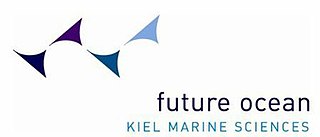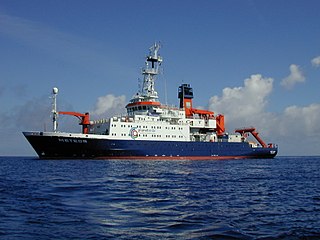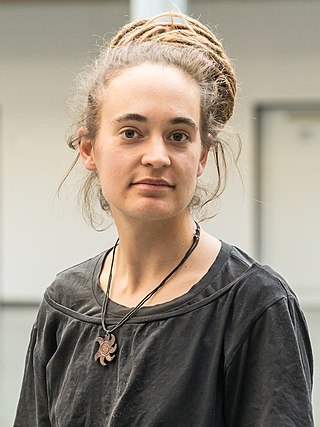
Otto Hahn was one of only four nuclear-powered cargo vessels built to date. Planning of a German-built trade and research vessel to test the feasibility of nuclear power in civil service began in 1960 under the supervision of German physicist Erich Bagge. Launched in 1964, her nuclear reactor was deactivated 15 years later in 1979 and replaced by a conventional diesel engine room. The ship was scrapped in 2009.
The Helmholtz Association of German Research Centres is the largest scientific organisation in Germany. It is a union of 18 scientific-technical and biological-medical research centers. The official mission of the Association is "solving the grand challenges of science, society and industry". Scientists at Helmholtz therefore focus research on complex systems which affect human life and the environment. The namesake of the association is the German physiologist and physicist Hermann von Helmholtz.

The Alfred Wegener Institute, Helmholtz Centre for Polar and Marine Research is located in Bremerhaven, Germany, and a member of the Helmholtz Association of German Research Centres. It conducts research in the Arctic, the Antarctic, and the high and mid latitude oceans. Additional research topics are: North Sea research, marine biological monitoring, and technical marine developments. The institute was founded in 1980 and is named after meteorologist, climatologist, and geologist Alfred Wegener.
Georg Adolf Otto Wüst was a German oceanographer. His pioneering work on the Atlantic Ocean provided a new view of the motions of water masses between the northern and southern hemispheres and the first evidence of the concentration of water mass spreading in western boundary currents.

The GEOMAR - Helmholtz Centre for Ocean Research Kiel (GEOMAR), formerly known as the Leibniz Institute of Marine Sciences, is a research institute in Kiel, Germany. It was formed in 2004 by merging the Institute for Marine Science with the Research Center for Marine Geosciences (GEOMAR) and is co-funded by both federal and provincial governments. It was a member of the Leibniz Association until 2012 and is coordinator of the FishBase Consortium. Since 2012 it is member of the Helmholtz Association and named GEOMAR - Helmholtz Centre for Ocean Research Kiel. The institute operates worldwide in all ocean basins, specialising in climate dynamics, marine ecology and biogeochemistry, and ocean floor dynamics and circulation. GEOMAR offers degree courses in affiliation with the University of Kiel, and operates the Kiel Aquarium and the Lithothek, a repository for split sediment core samples.
The Deutsches Klima-Konsortium e. V. is located in Berlin, Germany, and represents the leading players of German climate and climate impact research encompassing 26 renowned research organisations. The federation is also an important international partner acting as a guidepost, strategic partner, project partner and information broker.

The Future Ocean is a Cluster of Excellence founded in November 2006 in line with the German excellence initiative by the Christian-Albrechts-Universität zu Kiel (CAU), the Muthesius Kunsthochschule (MKHS), the Institut für Weltwirtschaft (IfW) and the Helmholtz-Zentrum für Ozeanforschung (GEOMAR). It is an interdisciplinary marine research group and it is funded by the German Research Foundation (DFG). Part of the cluster is the Integrated School of Ocean Sciences (ISOS) which is a post graduate school for ocean sciences in Kiel.

JAGO is the only crewed German research submersible. The submersible and the crew K. Hissmann and the pilot J. Schauer are based at the GEOMAR Helmholtz Centre for Ocean Research Kiel since 1 January 2006. The former owner was zoologist Hans Fricke from the Max Planck Institute for Behavioral Physiology in Seewiesen, Bavaria. JAGO can dive up to 400 metres (1,300 ft) and can carry one pilot and one observer. It can sample organisms, rock, gas and liquids, and can be used as a rescue and recovery vehicle for the northern Baltic Sea area. Due to the multidisciplinary connection between the GEOMAR and the Christian-Albrechts-Universität zu Kiel, scientists from the Cluster of Excellence "The Future Ocean" have occasional access to the submersible.
The ROV KIEL 6000 is a remotely operated vehicle built by Schilling Robotics, Davis, California. It's in the possession of the German GEOMAR - Helmholtz Centre for Ocean Research Kiel. The ROV has been designed for certain scientific tasks with a max. operational depth of 6,000 m. The ROV is electrically powered and directly linked to the operating ship via a deep-sea glass fiber cable. It can be operated from ships of opportunity which fulfill certain requirements such as deck space and stability, power supply, dynamic positioning and crane/winch capacities.
ROV PHOCA is a remotely operated underwater vehicle of the COMANCHE type. It was built by sub-Atlantic, Aberdeen, Scotland and is owned by the GEOMAR - Helmholtz Centre for Ocean Research Kiel. Its smaller size compared to the ROV KIEL 6000 and therefore its deploy ability from medium-sized research vessels makes it a complement to the QUEST type ROV. It can dive up to 3000m and was designed as a Work-Class- and Intervention-ROV.

The RV Meteor is a multidisciplinary research vessel operating mainly on the high sea. She is owned by the German state represented by its Federal Ministry of Education and Research and registered in Hamburg.

Hans-Ulrich Schmincke is a German volcanologist.
Günter Dietrich was a German oceanographer. He was the first to describe the Agulhas Current in detail, he provided essential contributions to the understanding of bottom water exchange in the North Atlantic and he shaped marine research in Germany after World War II.
Gerold Siedler is a German physical oceanographer. He is professor emeritus at the Christian-Albrechts University of Kiel and at the GEOMAR Helmholtz Centre for Ocean Research Kiel.
The Institut für Meereskunde in Kiel, Germany, existed from April 1, 1937 to January 1, 2004. It was an essential element of the long history of marine sciences in Kiel. This history started with the work of Samuel Reyher published in 1697 and is today continued within the GEOMAR Helmholtz Centre for Ocean Research Kiel.

Carola Rackete is a German ship captain and conservation scientist, who volunteered with the German sea rescue organisation Sea-Watch. In June 2019, she was arrested for docking a migrant rescue ship without authorization in the port of Lampedusa, Italy.

Sea-Watch 3 is a ship of the Sea-Watch organization based in Berlin. The ship is around 50 m long, and is registered as a Cargo Ship in Germany. Sea-Watch 3 is used for sea rescue in the Mediterranean.
Alan Kurdi, named after the drowned Syrian child of Kurdish origin, Alan Kurdi, is a ship which has been used since 2018 by the humanitarian organization Sea-Eye - under the German flag - and latterly the Italian humanitarian NGO, 'ResQ - People Saving People' for the rescue of migrants in the Mediterranean Sea. Before this, she was an oceanographic vessel operated by the Land of Mecklenburg-Vorpommern, named Professor Albrecht Penck.
Sea Eye 4 is an offshore supply ship that is used as a sea rescue ship. The Sea-Eye organisation moved the ship to the Mediterranean Sea in 2021 to rescue refugees.

Geo Barents is a rescue and salvage ship owned by Uksnøy & Co AS. She is currently chartered by Médecins Sans Frontières for sea-rescue operations of refugees in the Mediterranean since June 2021. Geo Barents is the sixth ship chartered or operated by MSF for humanitarian missions. Geo Barents sails under the Norwegian flag.










